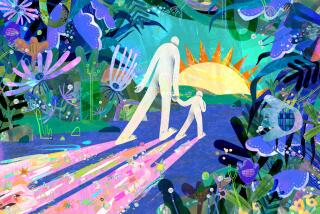Books that give kids a taste of other cultures
Oh, you can groan when the preschooler in your life crawls into your lap and demands, “Read this one to me.” But you know you love it. You know you love to watch them learn -- you can almost see the little mental gears turning (or, to use a more modern metaphor, the memory chips pulsing with each new download). And you know that you really enjoy some of the books yourself -- the bright colors, the silly rhymes.
These books carry the added advantage of taking their young readers somewhere: other countries, other cultures, other times. And you can come along too.
Iggy Peck, Architect
By Andrea Beaty,
Illustrations by David Roberts
Abrams Books for Young Readers: 32 pp.,
color illustrations, for ages 4 to 8, $15.95
Young Ignatius Peck is brilliant but also, to put it charitably, a handful. Beginning at age 2, he’s been constructing things of whatever was at hand, including a Pisa tower from (used) diapers. His creativity knows no geographical bounds: a sphinx in his backyard; a castle from sticks of chalk and a model St. Louis Arch “from pancakes and coconut pie.” His second-grade teacher, Ms. Greer, is unimpressed by Iggy’s work, believing that architecture has no place in her curriculum. (Poor thing, she was traumatized by being trapped in an elevator with a French circus troupe.) She changes her tune on the day a bridge collapses, and Iggy saves her. Some of Beaty’s rhymes are a bit strained, and readers who don’t like silliness will need to get over themselves. But it’s a good way to make kids think about the way the world’s buildings are made.
Five Little Gefiltes
By Dave Horowitz
G.P. Putnam’s Sons: 32 pp.,
color illustrations, for ages 4 to 8, $12.99
What Leo Rosten’s “The Joys of Yiddish” did for adults, Dave Horowitz’s “Five Little Gefiltes” might do for kids: introduce people of all cultures to Yiddish, in all its kvetching, shvitzing glory. The plotline is simple: Mama despairs as, one by one, her five children -- who look like matzo balls made out of fish -- disappear from the jar of Bubbe’s Homemade Gefilte Fish. They’ve gone to the theater (where “Little Miss Matzo” is playing) or to the deli (“such chutzpah”). It’s a baby borscht belt in a book, so enjoy already.
Each charmingly illustrated page not only tells the tale of the wayward kids, but also is plastered with little in-jokes from the Lower East Side of an era when a dozen eggs cost a nickel and a jar of schmaltz was just 2 cents. Adult readers may need to sneak an advance peek at the helpful glossary -- if they need a shmear of help explaining this meshugana language to their young audiences.
The Day the Stones Walked
By T.A. Barron,
Illustrations by William Low
Philomel Books: 32 pp.,
color illustrations, for ages 9 to 12, $16.99
Pico is embarrassed by his father. Unlike other fathers on Easter Island, who might teach their sons how to build a boat or hunt octopus, his “Pala” is obsessed by the great stone statues that look out over the ocean. The origin of these moai is a mystery, but -- how humiliating -- Pala thinks they can move, that they are the ancestors and protectors of the people. Pico changes his mind about them on the day of the Great Wave (we’d call it a tsunami). Half-drowned, he hears “the sound of great feet. . . . And voices, deeper than the sea itself.” Could it be that the stones walked? Well, that would explain a few things.
Barron’s dramatic text is matched by Low’s careful use of light and shadow in his compelling illustrations. Although the publisher targets the book for ages 9 to 12, younger readers could handle the scary parts if guided by a trusted adult through the flood sequence.
My Father’s Shop
By Satomi Ichikawa
Kane/Miller: 32 pp.,
color illustrations, for ages 4 to 8, $15.95
What seems like a spot of bad luck opens up a world for little Mustafa, who works in his father’s rug shop in Morocco. An otherwise beautiful rug is marred by an ugly hole. When Mustafa begs to keep it, his father agrees but with an “if” -- if Mustafa agrees to learn foreign words so that he can help with the many tourists who come into the shop.
But studying is no fun, so, wearing the carpet like a robe, Mustafa flees to the market where his friends are. A colorful rooster crows “kho-kho-ho-houuu” (which is how roosters crow in Morocco). This amuses a Spanish couple, who say that in Spain roosters say “Qui-qui-ri-qui!” But it’s “Koke-ko-kooo” in Japanese, and “Co-co-ri-co” in French.
Soon Mustafa, the rooster and tourists from many lands are back in Father’s shop, where Mustafa announces, “I can speak rooster in five languages.”
Angelina’s Island
By Jeanette Winter
Frances Foster Books: 32 pp.,
color illustrations, for ages 4 to 8, $16
Angelina is homesick. Instead of the rainbow-colored birds of her native Jamaica, she sees only gray pigeons on her Manhattan window ledge. The children’s games in New York are unfamiliar; the tall buildings hide the sun. “I close my eyes and feel my toes in the dust of a dirt road,” but when she opens them, she’s still in the cold city. She particularly misses Carnival.
Fortunately, Mama sees something in the newspaper: New York will have a carnival too. The ladies make her a brightly colored costume, while she practices dancing. Carnival day is a big success, for at its end, Angelina proclaims “This is my island in the sun.” (Vivid Caribbean colors enliven the figures of the people, who are seen in bold, black silhouette.)
Adèle & Simon
By Barbara McClintock
Frances Foster Books: 40 pp.,
color illustrations, for ages 4 to 8, $16
What if you were a conscientious little girl like Adèle, with an air-headed little brother like Simon? You’d have a full day. The two live in early-20th century Paris, in a world of soft watercolors based on period illustrations. If it takes a long time to turn the pages, it’s because each is filled with detail, from the cauliflower on the cart to the fossils in the natural history museum, to the filigrees of the Métro station entrance.
The story is simple: As Simon and Adèle travel from the Luxembourg Gardens to the Louvre to a cafe, Simon keeps losing things. His gloves, his crayons, his scarf and sweater all come up missing. Although he’s maddeningly untroubled by this, Big Sister is vexed. But just when it looks as though he’s going to be in trouble with Mama, all the people they’ve met that day show up at their front door, carrying all the stuff he lost. Simon is a lucky kid -- and so are the ones whose parents share this lovely book with them.
More to Read
Sign up for The Wild
We’ll help you find the best places to hike, bike and run, as well as the perfect silent spots for meditation and yoga.
You may occasionally receive promotional content from the Los Angeles Times.






